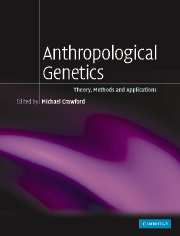Book contents
- Frontmatter
- Contents
- List of Contributors
- Preface
- Chapter 1 Foundations of Anthropological Genetics
- Part 1 Theory
- Part 2 Methods
- Chapter 4 The Importance of Field Research in Anthropological Genetics: Methods, Experiences and Results
- Chapter 5 The Confluence of Anthropological Genetics and Anthropological Demography
- Chapter 6 Molecular Markers in Anthropological Genetic Studies
- Chapter 7 The Use of Quantitative Traits in Anthropological Genetic Studies of Population Structure and History
- Chapter 8 Ancient DNA and its Application to the Reconstruction of Human Evolution and History
- Part 3 General Applications
- Part 4 Part IV The Human Diaspora
- Index
- References
Chapter 5 - The Confluence of Anthropological Genetics and Anthropological Demography
Published online by Cambridge University Press: 05 June 2012
- Frontmatter
- Contents
- List of Contributors
- Preface
- Chapter 1 Foundations of Anthropological Genetics
- Part 1 Theory
- Part 2 Methods
- Chapter 4 The Importance of Field Research in Anthropological Genetics: Methods, Experiences and Results
- Chapter 5 The Confluence of Anthropological Genetics and Anthropological Demography
- Chapter 6 Molecular Markers in Anthropological Genetic Studies
- Chapter 7 The Use of Quantitative Traits in Anthropological Genetic Studies of Population Structure and History
- Chapter 8 Ancient DNA and its Application to the Reconstruction of Human Evolution and History
- Part 3 General Applications
- Part 4 Part IV The Human Diaspora
- Index
- References
Summary
Introduction
The relationship between demography and evolution is close and long-standing. After all, it was by reading Malthus' (1798) essay on population that both Darwin and Wallace achieved their insight into natural selection. The importance of demography for anthropological genetics continues to be strong. Anthropological genetics, concerned with understanding the patterns and causes of genetic variation within and among populations, depends on anthropological demography to provide data on population sizes and fluctuations, mating structure, and migration patterns and histories that are crucial for that understanding.
While demographers study many aspects of human populations (Preston et al., 2001; Siegel and Swanson, 2004), anthropological demography usually focuses on small-scale populations and is often linked with studies of human biology. Anthropological demographic studies have been undertaken expressly to provide information necessary to understand genetic variation.
Demography is the study of human population. More specifically, as the classic definition states: ‘Demography is the study of the size, territorial distribution, and composition of population, changes therein, and the components of such change’ (Hauser and Duncan, 1959: 31). The size and composition of a population is caused by three fundamental factors: fertility (births), mortality (deaths), and migration (in-migration and out-migration). The discipline of demography has historically emphasized measurement and description of these vital processes, usually at the macro level of the national population. It is generally the population characteristics of countries that are analysed and compared (e.g. see Keyfitz and Fleiger, 1968).
- Type
- Chapter
- Information
- Anthropological GeneticsTheory, Methods and Applications, pp. 112 - 140Publisher: Cambridge University PressPrint publication year: 2006
References
- 1
- Cited by

